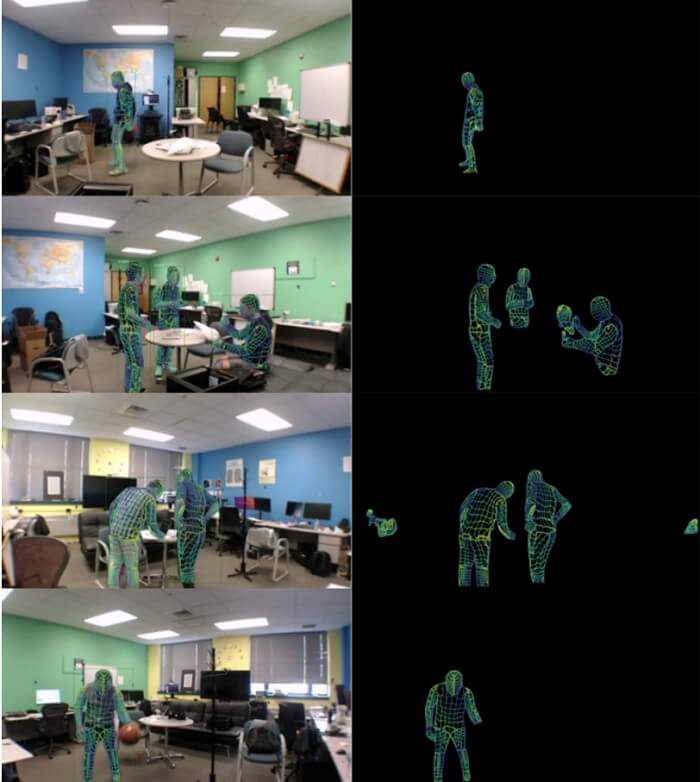Wi-Fi routers that can see through walls
Authored by: Jeff Brown via Bleeding Edge
Some interesting research out of Carnegie Mellon University caught my eye and may be cause for concern. A team there developed a method that uses everyday Wi-Fi routers to see through walls.
No kidding – this approach can detect humans and movement through walls. All using just the radiofrequency waves transmitted by a Wi-Fi router.
The team based this work on early artificial intelligence (AI) research from Facebook (Meta). They built upon it and created a neural network that can map the phase and amplitude of Wi-Fi signals sent and received by routers. Measuring the change in phase and amplitude is what enables the AI to effectively see through walls.
This image below shows us how it works:

On the left side we can see images captured using standard video equipment. On the right side we see the neural network’s Wi-Fi map detecting the presence of humans in the room.
What’s amazing here is just how detailed the Wi-Fi mapping is. We can see the exact position each person is in.
This looks like something out of a spy movie. And it’s easy to imagine how this technology could be used.
For starters, it’s fairly easy to hack into standard Wi-Fi routers. Most people never even change the network name and password that the routers come preinstalled with.
So it’s a good bet that any intelligence agency could hack into most Wi-Fi networks with ease. And with this technology, agents could immediately see how many people are in a house… and exactly where they are…
Obviously, this would be an incredibly useful tool in something like a hostage situation. Law enforcement wouldn’t have to guess about how many people were in the building… They would see it for themselves. And then they could develop a plan accordingly.
On the flip side, this technology also poses a privacy threat to all.
We’ve talked quite a bit before about how companies like Google and Meta capture as much data about us as they can. They use our data to create a dossier about our behaviors and preferences. Then they sell that information to advertisers at great profit.
Well, this is a tool that could be used for advanced data surveillance. It can be used to determine exactly what we’re doing in our home and when we’re doing it. It’s easy to envision router companies collecting data on our location and movements inside the home to sell to data aggregators, who then eventually sell access to that data to advertisers.
In fact, the eero router immediately comes to mind. Eero makes a fantastic product. It’s one of the best mass market Wi-Fi systems on the market. It’s affordable, simple to use, and has great performance.
However, Amazon acquired eero for $97 million back in 2019. And if we look at Amazon’s financials, it has become one of the largest advertising companies in the world over the last 36 months.
If we go back to 2018, Amazon had nearly zero advertising revenue. Today, advertising accounts for 7% of the company’s overall revenue. Last year, that equated to $37 billion in ad revenue.
What’s more, Amazon now produces almost as much free cash flow from ads as it does from its cloud services offering.
My point is, Amazon is now clearly interested in playing the same game Google and Facebook are playing
That being the case, it would not surprise me at all if Amazon begins collecting Wi-Fi mapping data from its eero routers. Understanding who is in the house and what they do would be very useful for ad purposes.
So here we have incredible technology that also poses major privacy concerns for consumers. This speaks to something I touch on frequently – technology is neutral. It can be used for good or ill… and it’s up to use to ensure that we use our technology mostly for good.
The challenge is, we don’t have many safeguards in place for this kind of Wi-Fi mapping.
The best we can do for now is go into our router settings and change the name and password to something much more secure. This will make our home networks more difficult to hack.
For help with how to adjust the settings, we should refer to our router’s instruction booklet. And if we didn’t save the physical copy, each instruction manual can be found online.
And Wi-Fi routers are just like our smartphones or computers. They run on software that’s frequently updated with security patches throughout the year. It’s highly recommended that we monitor those routers and ensure that they’re running the latest version of software with the latest security features.
This article was printed from TradingSig.com